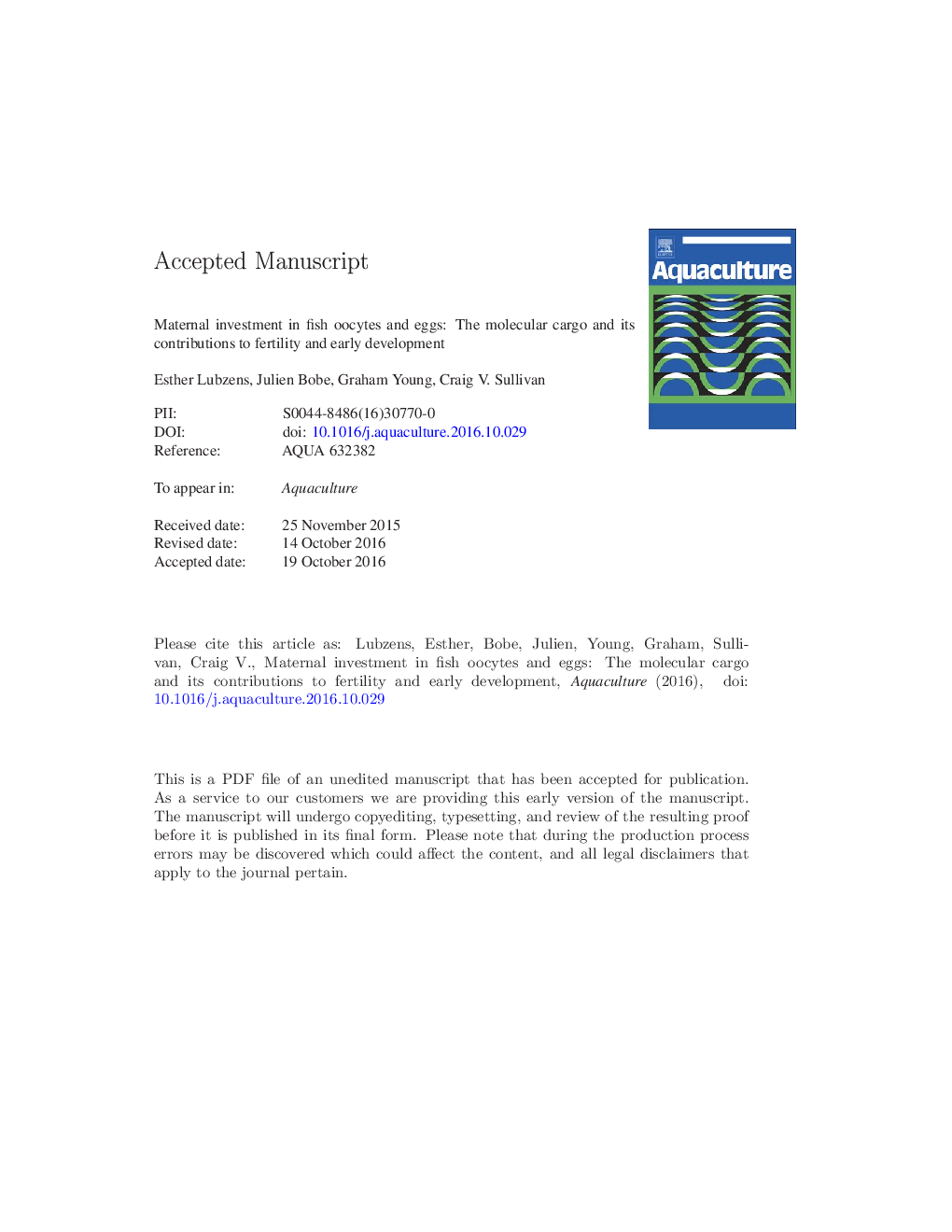| Article ID | Journal | Published Year | Pages | File Type |
|---|---|---|---|---|
| 5539188 | Aquaculture | 2017 | 161 Pages |
Abstract
The production of fertile eggs with the capacity to develop into larvae and subsequently into marketable fish is centrally important to the aquaculture industry. This entails not only the programmed production of large numbers of eggs, but also high quality eggs with the potential to support normal development and high survival of offspring to juvenile and later stages of development and growth. Numerous studies highlight the maternal contributions to the development of embryos, including transcripts that regulate cell division and determine oocyte polarity, pattern development during early and late embryonic stages and the transition from maternal to zygotic gene expression and translation. Since most fish embryos develop independently within an enclosed egg envelope, they rely on compounds deposited within the oocytes during their various stages of development. In addition to regulatory nucleic acids (maternal DNA and RNA), these include proteins and other compounds that contribute to the structure and function of the egg envelope and the bulk molecular cargo that will be used as a source of cellular energy and structural components for formation of embryos and larvae. These latter components notably include yolk lipids and proteins deposited during oocyte growth and water acquired at the same time and during cytoplasmic maturation. In this review we highlight recent advances made in revealing the transcripts deposited within the oocyte that contribute to the structural and morphological development of the embryo, and to the regulation of gene expression and translation during oocyte development. Significant advances have been made in revealing the molecular mechanisms of lipid accumulation and metabolism within the oocyte, the intricacies of yolk protein formation via endocytosis of multiple yolk precursor proteins by multiple oocyte receptors, and the complex machinery supporting massive accumulation of water by maturing oocytes of many species. Additionally, many advances have been made in our understanding of the endocrine regulation of all of these processes during oogenesis. We provide here an overview of recent advances in our knowledge on these various aspects of oogenesis and identify several gaps in our knowledge for future studies.
Keywords
STAT3EGFIGFESRmiRNAsLBDLRPHDLRNA-seqvWFPGRPGE2LDLRPPARCD36COAISHMPRlncRNAsncRNAsp62IKKEREsFAAPVSSPGMTPLVHEomesoderminMLH1CRB1FSHRPGSINHALPLVLDLTSHRLVLLAFSR-B1TGFbnotch1aOMCActRIIB17β-Hydroxysteroid dehydrogenaseCYP17A1piRNAsGVBDesgCYP11A1CYP19A1LHCGRGDF9CYCBPGCGTHCyclin Bfoxh1TrilobiteSoxB1P450c17ZGAGsdfDUF17pDAZLGPER1Cdc25AMH, anti-Mullerian hormoneSmad5Pou5f1RP2POU class 5 homeobox 1perivitelline spaceFSHR, follicle-stimulating hormone receptorPou2Mps1YSLPABPHsd3bOocyte Maturational competencesox9bVg1C-terminal peptideGnRH20β-hydroxysteroid dehydrogenase17,20β-dihydroxy-4-pregnen-3-oneC-T11KTApoe apolipoprotein Egrowth and differentiation factorsHNF3nucleoplasminPgf2apugSMIF11-ketotestosterone17α-Hydroxyprogesteroneapo BApoB, Apolipoprotein BAR, androgen receptorFSH, follicle-stimulating hormoneIn situ hybridizationLDLR, LDL receptorMTP, microsomal triglyceride transfer proteinQuantitative PCRq-PCRLong non-coding RNAspiwi-interacting RNAsnon-coding RNAsStAR, Steroidogenic acute regulatory proteinVLDLRGATAFree amino acidsEstradiol-17βMaturation-inducing steroidAMHApo EHCGoocyte maturationOvaltransforming growth factor-βgerminal vesicle breakdownRNA sequencingtriacylglycerolTAG یا triacylglycerols RykSnail1cluster of differentiation 36ligand-binding domaindomain of unknown functiondorso-ventralTranscription activator-like effector nucleaseTALENStarcell division cycle 25primordial germ cellsVasaepidermal growth factorTranscription factorrunt-related transcription factorVon Willebrand factorHepatocyte nuclear factor 3zygotic genome activationPhosvitinYolk syncytial layerhigh density lipoproteinvery low density lipoproteinlow density lipoproteinLDLLipovitellinsignal transducer and activator of transcription 3UTR یا untranslated regions untranslated regionMicroRNANanosGonadotropin-releasing hormoneHCG, Human chorionic gonadotropinGrowth hormoneFSHvtggerminal vesiclePoly(A)-binding proteinYolk proteinProstaglandin E2Prostaglandin F2αProstaglandinsmisScribblecoenzyme AGonadotropinGoosecoidMembrane estrogen receptorInsulin-like growth factor receptorperoxisome proliferator-activated receptorLuteinizing hormone receptorProstaglandin E2 receptorMembrane progestin receptor
Related Topics
Life Sciences
Agricultural and Biological Sciences
Aquatic Science
Authors
Esther Lubzens, Julien Bobe, Graham Young, Craig V. Sullivan,
